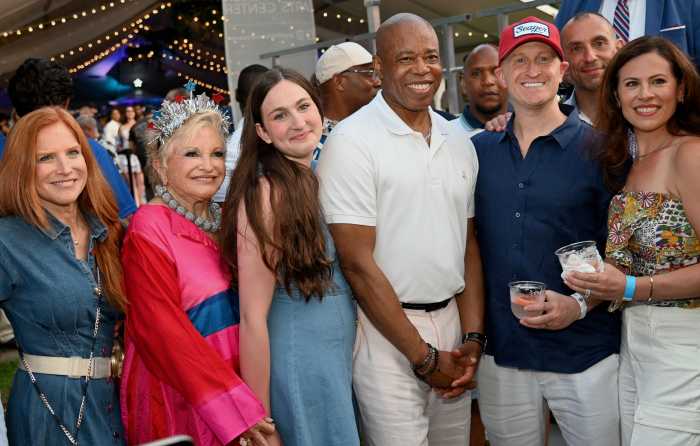“We show Black History all the time,” said Corrine Jennings director of Wilmer Jennings Gallery. Through March, selections from the master printmaker “Robert (Bob) Blackburn: Passages” is on exhibition at the Wilmer Jennings Gallery, 219 E. 2nd St., a satellite space of Kenkeleba House.
“I don’t think the Caribbean world knows that Blackburn is one of Jamaica’s (ancestry) most important artists,” says Jennings. Continuing, “Particularly for the opportunities he afforded others by creating a printmaking workshop, (first in 1947) in his apartment, opening it to others.”
It’s always Black History Month for Jennings and her collaborator husband artist Joe Overstreet whose Kenkeleba House, an East Village fixture for over 40 years is dedicated to the exhibition of artworks by African-American, Latino, Asian-American and Native American artists.
On Feb. 14 at 3:00 p.m. there will be a gallery tour and on March 14 at 3:00 p.m, a panel discussion.
Blackburn, whose parents were from Jamaica, grew up in Harlem in the 1930s taking printmaking classes as a young teen at the Harlem Community Arts Center conducted by the Works Progress Administration (WPA). This was also the time of the Harlem Renaissance’s cultural fomenting when creativity and production flourished in Harlem. After DeWitt High School, he attended the Art Students League on a scholarship.
Jennings explained that the artist was devoted and known for his Chelsea-located Blackburn Printmaking Workshop, which moved to a larger W. 17th St. space in 1948.
“He often gave scholarships. He really wanted to expand and encourage young people and their relationship with paper.” It eventually became an artists’ cooperative and then a non-profit. After his death, the workshop was incorporated into the programs of the Elizabeth Foundation for the Arts offering cooperative printmaking workspace, access to skilled staff and studio space.
She added, “He helped so many adults, black and white.”
In 1992 at age 70, Blackburn received the MacArthur (genius) Award. “He gave most of that money to help other artists,” Jennings said.
Continuously creating art, during his lifetime he exhibited in many group shows but this is the first retrospective of the master printmaker.
The exhibition is chronological starting with the extraordinarily accomplished work that he produced in the late 1930s as a student at the Bronx’s DeWitt High School (James Baldwin attended DeWitt, also.) Under a glass display are Blackburn’s illustration graphics for the high school’s literary Magpie magazine.
The galleries four rooms take you through Blackburn’s artistic stages. In the early 50s, he received a traveling fellowship and spent a year in Europe while his friends kept his studio going. He returned by 1955 and began producing lithographs, still lives, and eventually abstractions where he tried various versions, rotations and colors.
In his life of printmaking, Blackburn practiced block printing, stone lithography, etching, monoprinting, dry point, intaglio and color viscosity, innovating and bringing to mainstream varying printing techniques.
In 2001, MTA Arts for Transit commissioned Blackburn to create a work for the 116th St./Lexington Ave. subway station in East Harlem. He chose artist Mei-Tei-Sing Smith, a Bearden Fellow at the Printmaking Workshop, to assist him on what would prove to be his last major project. His designs were enlarged and executed in ceramic and glass mosaics. Blackburn died in 2003 at the age of 83, before the completion of the project in 2005.
On a recent Saturday, a first semester art student at the Art Institute of New York visited the gallery. “Jessica Augier, my print-making teacher told us about this exhibit,” she said as she and a friend meticulously looked at each piece. Also at the gallery were two women from the Baltimore/Washington area. Braving ice and cold, one said, “I always stop at this gallery when visiting New York.”
A couple dozen donor sponsors helped produce this important exhibition curated by Deborah Cullen under the auspices of The David C. Driskell Center at the University of Maryland, College Park, which mounted the full exhibition in October, 2014. A 145-page catalogue accompanies the exhibition.
























